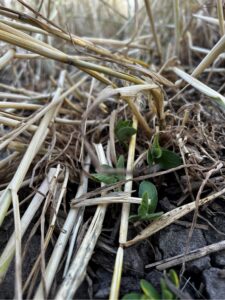Previously, we were in the Spring of 2021. It was a late planting season, and we decided to take our cereal rye to anthesis and then crimp it as we planted soybeans into the living cereal rye.
It was a beautiful stand of rye, and we caught it at the right time, just as it was starting to pollinate. The planter performed well and as we fought off the pollen from the radiator, we finished at dusk. Sharp double disk openers and hydraulic downforce sliced through the rye and the new FurrowForce closing system sealed the furrow magnificently. The next day we rolled the rye down and it covered the ground with a lush mat that would protect the clay soil from crusting, suppress weeds, and hold the moisture later in the season.
One of my favorite attributes of the cereal rye is that it scavenges a tremendous amount of nutrients from the soil and holds it to be released later in the season. My opinion with soybeans is that soybeans can be stressed earlier in the season, which causes them to produce more and bigger nodules to produce their own nitrogen from the air. Much like working out, a little stress makes them stronger in the end. With more plentiful nodules, coupled with the nitrogen being released by the decaying cereal rye, the soybeans are poised for a stronger finish. In addition to nitrogen, potassium is time released throughout the season as well. Slowing the vegetative growth in the beginning of the season will help to shorten the plant. Nodes closer together are more efficient and will stand better in later in the season. Plus, it will promote branching of the soybean plant.
After rolling, we sprayed with Authority XL and glyphosate. (I wonder if we even needed the Authority XL and the glyphosate was to make sure the rye was terminated). The soybeans emerged from the heavy mat and the stand was admirable. Final stand was about 110,000 plants per acre. The heavy timber clay soil, that could use a couple thousand feet of tile, was a crumbly mass of roots, glomalin, and earthworm excretions. It was a great environment for those soybeans to emerge. When the soil looks like chocolate cake, you know it is right.
A few weeks later, we were scouting, and noticed that this field had very little weed pressure. The other soybean fields were getting furry with waterhemp and were getting a cocktail of Liberty and Enlist to remedy the problem. I debated about not spraying and decided to only spray some Dual (s-metalechlor) as a residual and leave out the Liberty, since we saw no visible signs of weed pressure. This cut out a pass with Liberty since we planned to spray it twice. Thirty dollars an acre in my pocket (which paid for the rye). When the cereal rye was starting to decompose later in July, we sprayed the Liberty, as the waterhemp were finally showing up.
As the growing season proceeded, we had ample rains and the plants looked poised for a strong finish. Then we turned dry. But the mat of cereal rye helped hold in the moisture later than the other fields of soybeans.
As we pressed on to harvest, these soybeans yielded 66 bushel per acre, which was very good for being planted at the end of May. This field has now been in cover crops for six years and previously had drowned out spots and very variable stands. The cover cropping helped to keep the soil from crusting, improved water infiltration and helped control weeds, in addition to feeding the soil biology and sinking carbon back into the soil.
The challenge to planting into mature cereal rye in Central Illinois, is that in order to do so, we must wait until later in the spring to plant. This tends to typically give up yield. I am still glad that I got to have the experience. And if we have another wet, late spring, I will be confident in planting green, rolling the rye and setting the crop up for success.





 and then
and then